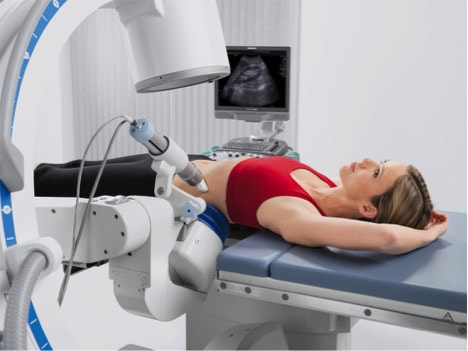Shock Wave Treatment for Urinary Stones
We are proud to offer state-of-the-art, non-invasive technology to our kidney stone patients, which makes treatment more safe, efficient, convenient and cost- friendly that traditional methods.
ARRIVAL OF CARRIBEAN’S FIRST MOBILE SHOCK WAVE MACHINE FOR KIDNEY STONES
Advanced Urology is delighted to be associated with Jamaica Urological Partners in providing this first-of-its-kind treatment form to the Caribbean. Extracorporeal shock wave lithotripsy (SWL) is a method of treating kidney stones and stones in the ureter that avoids the need for surgery. In SWL, high energy shock waves are passed harmlessly through the body and used to break kidney stones into smaller pieces the size of grains of sand. These are then passed painlessly in the urine over the next few days.
Click here to see information video for ESWL
ARRIVAL OF CARRIBEAN’S FIRST MOBILE SHOCK WAVE MACHINE FOR KIDNEY STONES
Advanced Urology is delighted to be associated with Jamaica Urological Partners in providing this first-of-its-kind treatment form to the Caribbean. Extracorporeal shock wave lithotripsy (SWL) is a method of treating kidney stones and stones in the ureter that avoids the need for surgery. In SWL, high energy shock waves are passed harmlessly through the body and used to break kidney stones into smaller pieces the size of grains of sand. These are then passed painlessly in the urine over the next few days.
Click here to see information video for ESWL
The mobile unit offers extra convenience to you, as the machine can be brought to any of our participating hospitals closest to you, on an island wide basis. The service is offered as a day procedure, so you are able to go home afterwards.
ESWL for Kidney Stones
What to Expect
- You are placed on a water-filled cushion, and we locate the stone with X-rays. Then shock waves are focused on the stone, passing painlessly thru the kidney and body muscles to break the stone in to many small fragments. These small pieces move through the urinary tract and out of the body more easily than a large stone.
- The process takes about an hour.
- You may receive sedatives, local or general anesthesia.
This treatment avoids surgery, has lower complication rates, and minimizes hospital stays, costs and recovery time. However, not all types of kidney stones can be treated with SWL.
What to expect after treatment
ESWL is usually an outpatient procedure. You go home after the treatment.
If you have a larger stone, you may need more ESWL or other treatments. Plan to spend one to two days resting after your procedure, but most persons can return to work the following day.
Long-term outlook for people with kidney stones
The stone-free rate after ESWL is comparable to other surgical treatments. Recovery may vary depending on the number and size of the stones, but lithotripsy can usually remove them completely. In some cases, additional treatments may be needed. While lithotripsy works very well for most people, there’s a 50% lifetime chance that stones will return, regardless of what method was used to treat them. Life-long follow up aimed at lifestyle and dietary modification, under the guidance of an experienced urologist, is essential in helping to prevent any further stone episodes.

